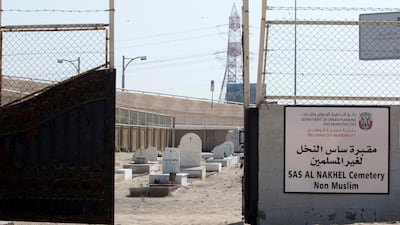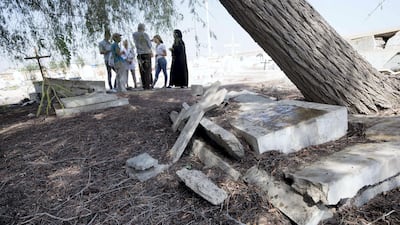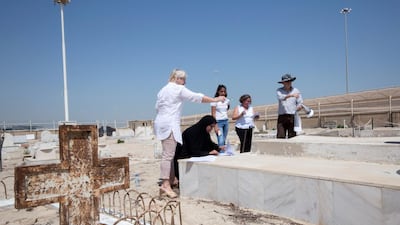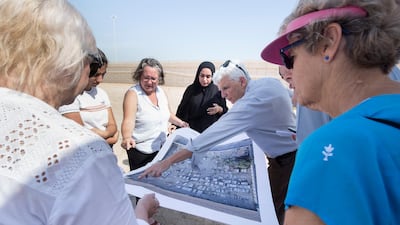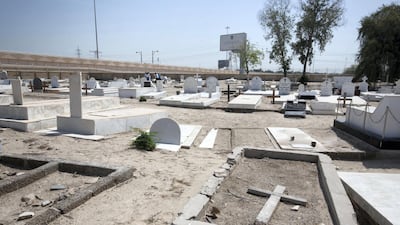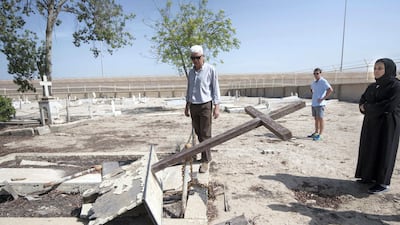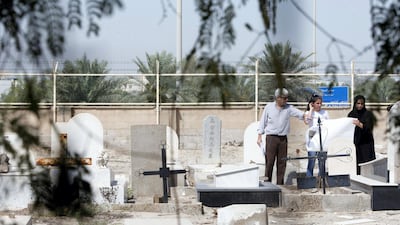The inscription on the tomb is just a few simple lines: “In memory of our little angel. Born June 24, 1997. Died June 24, 1997.” A few candles and flowers are also scattered around the grave.
It is just one of dozens of infant graves in Abu Dhabi’s non-Muslim cemetery. Many died in the 1970s and 1980s when mortality rates were much higher.
The now-closed Sas Al Nakhl graveyard is also the final resting place for hundreds of Abu Dhabi residents including military commanders, Chinese labourers and Indian workers.
Some of those buried there died in air accidents, others in industrial incidents. Old age, drowning, sickness and suicide claimed others. Mystery surrounds some.
But there are no road signs revealing the cemetery’s existence. After you cross Sheikh Zayed Bridge from the city, it is possible to glimpse a small square patch of ground surrounded by nothing but roads, power lines and sand. There, under the harsh sun, sit rows of tombstones with faded inscriptions in English, Arabic and Mandarin while others lie cracked and upturned among the weeds.
To mark the Year of Tolerance, a team from Khalifa University is now trying to find out more. Led by Dr Athol Yates, an assistant professor, volunteers including Emirati students are aiming to create an online map where people can click on a grave and view details about that person.
“This really gives you more of a feel about the contributions of individuals over the decades,” Dr Yates says.
Take Roland Pope. Pope was born in 1924, joined the British military and became a senior commander in the Abu Dhabi Defence Forces, the emirate’s security force before the army was unified. He died on April 14, 1976, in a helicopter crash near the airport in foggy conditions.
Or Wang Bao Xiang, a Chinese labourer from the Jilin Construction and Development company who died in an industrial accident here in 1997.
“There was a huge influx of Chinese labour but it has dropped off in the past 20 years,” Dr Yates says.
A third is Margaret McKay, a British politician who became a champion of Palestinian rights. McKay moved to Abu Dhabi in the 1970s, became a friend of the late President, Sheikh Zayed, and died here on March 1, 1996.
“By having these memorials you realise that it is the individual who made the contribution – not just 200,000 expatriates," Dr Yates says. “That gives it a nice feel.”
The work has taken months. At least 500 people are buried there and about 250 graves have been identified. Teams visited churches to study death certificates, burial records and pastoral books. They then numbered each grave, took photographs and began building a picture, where possible, of each tomb.
Mariam Zaal Alhameiri is one of about ten Emirati volunteers participating in the project. A postgraduate student at Zayed University, her house is only a short drive away yet she never knew the cemetery existed.
“The most striking records I see are of babies dying,” she said. “Some were born in 1992, the year I was born. So I was thinking if they lived, maybe I would have met them in university or school.”
It is believed that Sheikh Shakhbut, Ruler of Abu Dhabi, granted land for the site in the 1960s. It was then managed by the Anglicans and other churches paid them a maintenance fee to bury people there. Buddhists, Hindus and Christians are buried side by side.
By 2012, the cemetery was closed and was replaced by a new facility in Bani Yas. Today, some people still come to pay their respects but it mostly sits undisturbed in the shadow of ever-encroaching new motorways and buildings.
“We will probably never get the exact number of who is there because some graves made of wood have disappeared,” Dr Yates says.
It is hoped the work will be complete within a few months and more details about where to view the database will be announced soon. But the task of compiling the biographies will go on indefinitely.
“Some contact has been made with the families,” he says. “We are reaching out when we find them. [And we hope] more people will come forward.”

